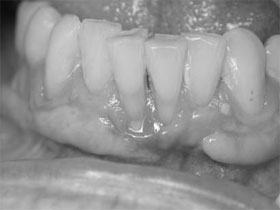Site Preservation
A key to implant success is the quantity and quality of the bone where the implant is to be placed. In today’s world we have the technique to rebuild bone anywhere in the dentition. The upper back jaw has traditionally been one of the most difficult areas to successfully place dental implants due to insufficient bone quantity and quality and the close proximity to the sinus. If you’ve lost bone in any area due to reasons such as periodontal disease or tooth loss, you may be left without enough bone to place implants and bone augmentation is needed to prepare the site.
Careful management of extraction sockets after tooth extraction prevents unsightly bone loss and provides a better cosmetic outcome for tooth replacement.

Pre Op

Defect in Bone

Pattern for Membrane

Regenerated Site, 14 Weeks Later
Regrowing your lost bone
A key to implant success is the quantity and quality of the bone where the implant is to be placed. If you’ve lost bone in any area due to reasons such as periodontal disease or tooth loss, you may be left without enough bone to place implants and bone grafting allows us to prepare the site for an implant. Periodontal disease or a tooth abscess will cause bone loss around teeth, hastening tooth loss. Once teeth have been lost, supporting jaw bone continues to disappear especially when combined with long term denture use, resulting in a compromised ability to chew the right food you need for your health.
Simple, predictable techniques are available to regrow your lost bone, to provide support for implants or dentures, or to improve esthetics beneath fixed bridge work.
These bone regeneration procedures do not require bone to be taken from another part of your body. Instead, membrane barriers are utilized over a variety of grafting materials to rebuild your lost bone.
The membrane barrier prevents the gum tissue from growing into the area of bone loss which is to be rebuilt, and protects the underlying bone that is forming.
The grafting materials which have been placed beneath the membrane barrier encourage your own bone to grow into the area.
This method of bone regeneration is highly predictable, and often results in complete regeneration of the lost jaw bone in the area being treated.
Regrowing your own bone offers a number of advantages including:
- Regeneration of sufficient bone to place implants in the proper positions to support a variety of restorations.
A key to implant success is the quantity and quality of the bone where the implant is to be placed. - Regeneration of bone to provide greater stability for full dentures.
- Regeneration of bone to improve esthetics and function.
Patient age, or the length of time that bone has been missing, are not negative factors when considering bone regeneration therapy.
In today’s world we have the technique to rebuild bone anywhere in the dentition. Implants placed in grafted sinus bone have a 95% success level!
Extraction with Site Regeneration
Building up the Bone


An Instrument in the socket show there was no bone at the face of the tooth. This bone can be recaptured with Site regeneration.
Frequently dental disease will not only damage the tooth but it will damage the surrounding bone as well. Now there are simple techniques to recapture the lost bone.
